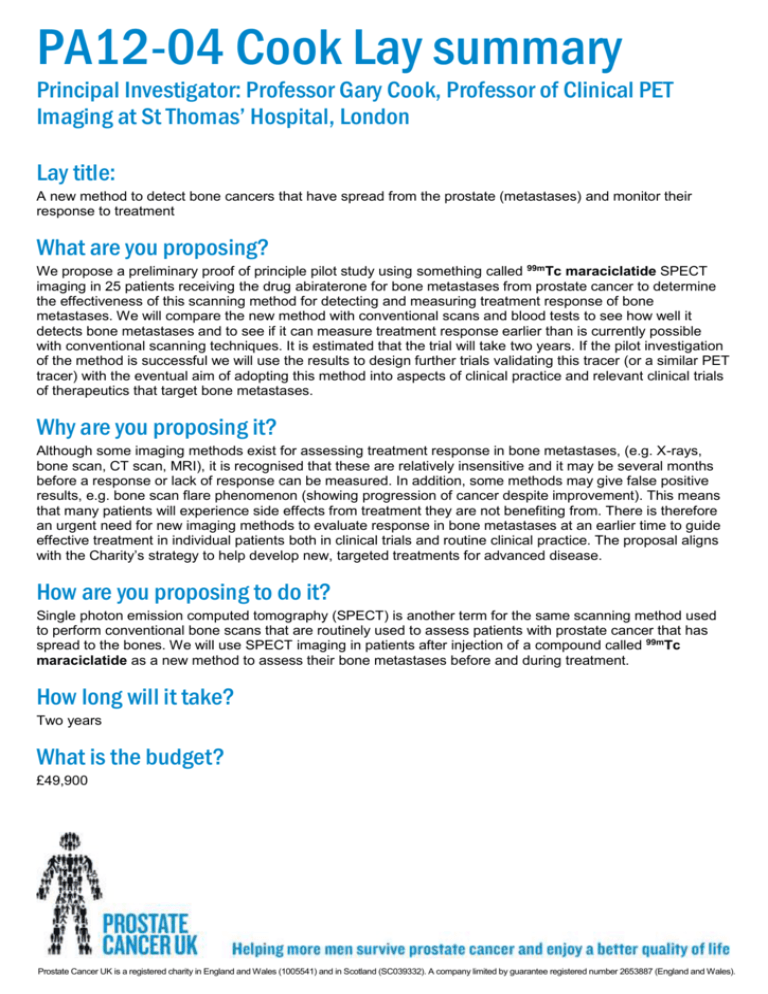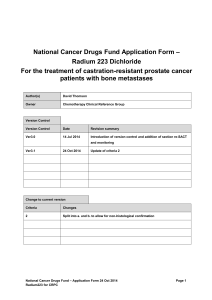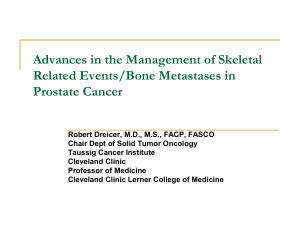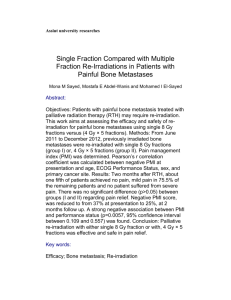PA12-04 Cook Lay summary Principal Investigator: Professor Gary
advertisement

PA12-04 Cook Lay summary Principal Investigator: Professor Gary Cook, Professor of Clinical PET Imaging at St Thomas’ Hospital, London Lay title: A new method to detect bone cancers that have spread from the prostate (metastases) and monitor their response to treatment What are you proposing? We propose a preliminary proof of principle pilot study using something called 99mTc maraciclatide SPECT imaging in 25 patients receiving the drug abiraterone for bone metastases from prostate cancer to determine the effectiveness of this scanning method for detecting and measuring treatment response of bone metastases. We will compare the new method with conventional scans and blood tests to see how well it detects bone metastases and to see if it can measure treatment response earlier than is currently possible with conventional scanning techniques. It is estimated that the trial will take two years. If the pilot investigation of the method is successful we will use the results to design further trials validating this tracer (or a similar PET tracer) with the eventual aim of adopting this method into aspects of clinical practice and relevant clinical trials of therapeutics that target bone metastases. Why are you proposing it? Although some imaging methods exist for assessing treatment response in bone metastases, (e.g. X-rays, bone scan, CT scan, MRI), it is recognised that these are relatively insensitive and it may be several months before a response or lack of response can be measured. In addition, some methods may give false positive results, e.g. bone scan flare phenomenon (showing progression of cancer despite improvement). This means that many patients will experience side effects from treatment they are not benefiting from. There is therefore an urgent need for new imaging methods to evaluate response in bone metastases at an earlier time to guide effective treatment in individual patients both in clinical trials and routine clinical practice. The proposal aligns with the Charity’s strategy to help develop new, targeted treatments for advanced disease. How are you proposing to do it? Single photon emission computed tomography (SPECT) is another term for the same scanning method used to perform conventional bone scans that are routinely used to assess patients with prostate cancer that has spread to the bones. We will use SPECT imaging in patients after injection of a compound called 99mTc maraciclatide as a new method to assess their bone metastases before and during treatment. How long will it take? Two years What is the budget? £49,900 Prostate Cancer UK is a registered charity in England and Wales (1005541) and in Scotland (SC039332). A company limited by guarantee registered number 2653887 (England and Wales). Why is this project suitable for a pilot award? There are supportive preclinical data confirming that other forms of imaging can target osteoclasts (bone cells) and tumour blood vessel formation and preliminary human data confirming uptake in bone metastases in prostate cancer. However, there are no studies specifically investigating the ability of this imaging technique in bone metastases. Therefore, as a pilot study we will determine the effectiveness of this scanning method for detecting and for measuring treatment response of bone metastases in prostate cancer. If this imaging technique successfully detects bone metastases and predicts response in this pilot study, we will use the results to design studies to more accurately evaluate the effectiveness of this agent to predict response to current and new treatments for bone metastases in prostate and other cancers. What are the expected outcomes? Measurement of the sensitivity of expression of a protein called integrin as measured by 99mTc-maraciclatide in prostate cancer bone metastases. It is anticipated that the new imaging method that can target both blood vessel formation and the high level of osteoclast integrin expression in metastases will be at least as sensitive as conventional imaging. Comparison of changes in integrin expression in patients being treated for bone metastases from prostate cancer in clinical responders and non-responders. It is expected that by measuring downstream effects on osteoclasts and blood vessel formation that this method will show relevant early changes following effective therapy. How could it make a difference to the lives of men affected by prostate cancer? Prostate cancer commonly spreads to bones and more than 70% of the 8,500 patients dying of end-stage prostate cancer in England each year have bone metastases. Bone metastases are associated with significant disease effects, including pain, fractures at sites of cancer and spinal cord compression. Effective pain relief treatments are available but less than 50% of patients respond and all treatments are associated with some side effects. Accurate methods to differentiate responders from non-responders are needed for clinical trials of new therapeutics and in clinical practice to help optimise treatment in individual patients. Please write a summary of the project in one sentence only. We propose a proof of principle pilot study using 99mTc maraciclatide SPECT imaging in bone predominant prostate cancer to determine the effectiveness of this scanning method for detecting bone metastases and measuring treatment response.










